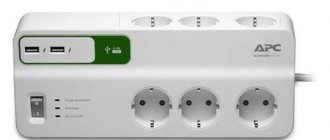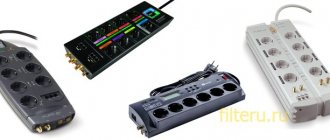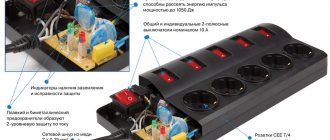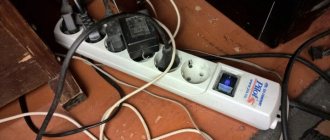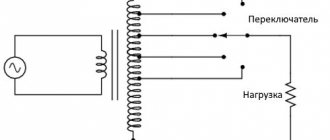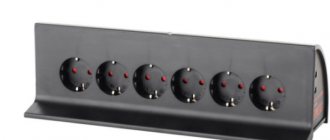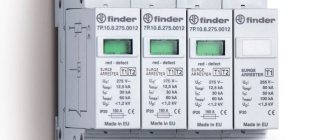The operation of electrical and electronic devices occurs due to the supply of mains current. The energy flow through the wires brings with it satellite electromagnetic fields. They pose a threat to the accuracy of the performance of their functions by electricity network subscribers. Network filters (SF) can solve this issue. You can always buy them in the form of network extension cords. Knowing the network filter circuit, the device is easy to assemble with your own hands.
Network filter
Operating principle of a surge protector
The AC voltage in the 220 V network changes in a sinusoidal form. The correct shape of the electrical impulse is “contaminated” by electromagnetic interference. A sine wave looks like a bending line of a pure signal, surrounded by a network of stray currents caused by phase imbalances, surges and voltage surges.
Mains current graph
Accompanying noise affects sensitive components of electronic circuits of various devices and equipment. The problem arises of clearing the current from parasitic formations. For this purpose, a surge filter (SF) is used.
SF is built between the mains current source and consumers. It consists of chokes and capacitors connected in a certain order. The work of the filter is to build the inductive reactance of the coils, which does not allow high-frequency interference to pass through. The device's capacitors cut off unwanted interference. Capacitors complete the circuit and do not allow parasitic pulses to pass through.
Simple surge protector device
DIY laboratory power supply
There are two types of SF:
- Built-in.
- Stationary – multi-channel.
Built-in
Compact SF boards are part of the internal structure of various electronic equipment. They are equipped with computers and other complex equipment.
Built-in network filter board
The photo shows the SF device. The following parts are installed on the board:
- VHF – capacitor;
- toroidal throttle;
- additional capacitors;
- varistor;
- induction coils;
- thermal fuse.
A varistor is a resistor with variable resistance. If the standard voltage threshold (280 V) is exceeded, its resistance can decrease tens of times. The varistor performs the function of surge protection.
Stationary – multi-channel
The device body has several sockets. Thanks to this, it is possible to connect all existing electrical equipment in one room to one outlet through a filter. To remove high-frequency radio interference, a simple LC filter is used. Fireproof thermal fuses prevent power surges. Some models use disposable fuses.
How to choose?
The best option, which combines the properties of a surge protector and a stabilizer in one device, is a UPS with a battery, which is an uninterruptible power supply. The UPS is characterized by a smooth sinusoidal voltage drop, so it is used to stabilize the operation of household appliances and computers. The choice of a surge protector for home or professional use is made after studying all the features and characteristics of the electrical network. Many modern buildings have grounding, but there are old buildings that do not have such protection; for such cases, a reliable surge protector is required. Often in one apartment different filters are used for the TV, for the refrigerator, for home equipment.
When choosing a surge protector, you need the following.
- Determine the power of the device - calculate how many devices and with what power will be simultaneously connected to the filter, add a margin of at least 20% to the total number.
- The parameter of the maximum energy of the input pulse is important - the higher this indicator, the more reliable the network device will be.
- Determine whether there is a thermal fuse in the filter that protects the filter from overheating.
- Determine the number of sockets to connect, and if devices need to be frequently disconnected from the network, then it is better to choose a filter with autonomous shutdown of each socket.
- Consider what length of electrical cable will be needed.
Making your own surge protector
It will not be at all difficult for a radio amateur to make the simplest surge protector with his own hands at home. To do this, you need to build a small circuit inside the body of a power strip with several outlets. The picture below shows how to do this.
DIY SF
DIY power supply for 12V screwdriver
Install the SF in the extension cord as follows:
- Open the housing of the power strip.
- Resistors R1, R2 and chokes (inductive coils) L1, L2 are soldered into parallel branches after the switch and varistor.
- Then the branches are alternately closed through capacitor C1 and one resistor R3.
- Installation of the end capacitor C2 can be done anywhere between the sockets.
Important! If there is no room inside the extension cord housing for the second capacitor C2, then you can do without it. It is enough to adjust the parameters C1.
Chokes are used with open ferrite cores with inductance from 10 μH. Capacitors are selected in the range of 0.22-1 µF. The resistance of the resistors correlates with the planned power of consumers. At a load of 500 W, 0.22 Ohm resistors will be required. Resistance R3 must be at least 500 kOhm.
Details
Surge filter circuit for 220 V
- High-frequency oscillations, hitting the inductor, increase its degree of resistance and therefore will not pass further (inductive resistance is proportional to the frequency).
- Contacts on the capacitor will dampen high frequencies if the capacitance is chosen correctly (the resistance of the capacitor with this connection method is inversely proportional to the frequency of current oscillations).
It will act as a load for an element such as a capacitor when the power is turned off (a free type of charge may begin to accumulate on the capacitor, which is dangerous even after 100% disconnection of the filter from the AC mains). You can make the simplest surge protector yourself. By the way, it is best to buy a ferrite filter in the form of an extension cable with a detachable diameter. Its purpose in the operation of the circuit is to suppress high-frequency interference along the power supply circuit by increasing the conductor inductance, as well as absorbing radiation directly by the ferrite. This is an excellent solution for connecting home appliances to the power supply. Other implementations of the network electrostatic precipitator are also possible. As an example, we can cite the diagrams that are used in the Pilot technique. We provide you with instructions on the assembly process of a conventional network filter yourself. Assembling a filter from the proposed circuits is quite simple, and this does not require printed circuit boards or a single housing on an extension cord. With a good choice of the size of the elements and their layout, they can be placed in the housing of an inexpensive varistor filter for the network. The circuit that is available must be cut (contacts from the varistor to the sockets, leaving the varistor itself), and the elements will be placed in accordance with the diagram and soldered. Everything should work out as planned.
Capacitors C1 and C2 can be combined into one if there are the necessary indicators and free space. Or, on the contrary, dial using several parallel connections, if free space allows. It is best to use film capacitors from 0.22 to 1 µF. It is better to take the maximum permissible voltage with a reserve (in case of interference with sudden voltage changes), for example, up to 680 V. Resistance R3 should be from 0.5 to 1.5 MOhm. It is also better to take power with a reserve for better thermal output of 0.5 W. In circuit No. 3, the coils and capacitor will be changed, and it is the coils that have the most optimal inductance indicators for their small size and the tasks facing them. It turns out that you will use much fewer parts for soldering.
Precautionary measures - what is important to consider
A self-made surge protector with a voltage of 220 V is a complex technical device. Its assembly process is impossible without knowledge of electrical engineering. All work must be carried out in compliance with all safety measures. Otherwise, there is a risk of electric shock. As was written earlier, the capacitors were designed for high voltage.
They are capable of accumulating a residual charge. A current shock will be possible even after a complete filter disconnection from the mains (alternating current). For this reason, a resistor connected in parallel is mandatory.
Before soldering, you need to make sure that all elements are in good working order (it is important to measure the basic parameters with a tester and compare them with the declared ones). Wires should not be allowed to cross, especially in places of potential heating (on exposed contacts and resistors)
Before connecting to the network, it is important to make sure (that is, “ring” using a tester) if there is no short circuit.
Scheme of SF protection against network interference
A typical network filter circuit is the basis of all devices of this type, with the exception of additional details. The classic is connecting to the points: Ground, Phase and Zero. A varistor VDR 1 is installed at the input. It suppresses voltage surges in the mains current. With a high voltage surge, the resistance of the varistor drops sharply, thereby preventing the interference from passing further through the circuit.
To dampen small voltage changes, inductor Tr1 and three capacitors C are used. Capacitors C1, C2 and C3 are reactive radio components that constantly change the resistance level. It increases sharply when the current frequency changes.
Normal current passes through the filter unimpeded. At the same time, high-frequency interference is delayed in the SF. The filter resistance is directly proportional to the current frequency. Both indicators increase simultaneously, which makes it possible to delay interference on the way to the consumer.
Note! A three-wire power supply network may be subject to interference in the phase-zero, ground-phase, and ground-zero sections. Effective suppression of such negative phenomena is carried out by normal standard grounding of the SF.
Ways to Improve the Filter Circuit
There are many options for improving the network filter circuit. One of them is ingenious and allows you to significantly save energy consumption. The essence of the method is as follows:
- Open the housing of the multi-connector SF extension cord.
- One of the current-carrying busbars is cut.
- The segments are connected to a 5 volt relay, designed for switching current 3A, 250 V.
- The other two relay contacts are connected by wires to a USB connector at the end.
- The connector is connected to the USB input of the TV.
The result is a controlled power system consisting of a TV, a digital set-top box and a satellite dish power supply. If previously, when the TV was turned off, all parts of the system remained in standby mode, then with the upgraded filter they are completely turned off. As soon as you turn on the TV using the remote control, all the switched devices are also activated and vice versa.
Additional Information. Various modernized SFs can always be found on the radio market, but they are quite expensive. Therefore, it is much more profitable to improve the device yourself.
In another case, they take the path of adding an LC filter to the SF, which, in addition to suppressing interference from the network, reduces mutually occurring electrical interference from connected consumers.
A standard varistor (470 V) often does not trip the automatic fuse. It is replaced with a similar device designed for a voltage of 620 V. This allows you to suppress interference from a running washing machine, vacuum cleaner and other powerful electrical equipment.
Home craftsmen equip surge protectors with audible alarms. When the voltage level in the network exceeds 280 V, the filter notifies you with a signal.
Option 1: new building
Let's first consider the most optimistic scenario: a newly commissioned new building with a brand new substation;
The wiring is made exclusively of copper with perfect installation, high-quality contacts that have not yet oxidized and automatic fuses for the appropriate current. It would seem that the voltage in the outlet should be as close as possible to an ideal sinusoid. Alas, even such an idyll can easily be ruined for a couple of months by a hop-up group with a broken-down tool invited by a neighbor for repairs: each electric motor in each dying angle grinder, drill or chipper will spark with all its might until its final feature, sending “death impulses” along the wiring of the house. .
This is just the beginning: the most active and restless residents will periodically connect industrial welding machines to their home network so that all neighbors in the entrance or house can “enjoy” pulsed noise in the form of stripes on TV and PC screens and a loud crackling sound in speakers and headphones.
So, even residents of relatively new microdistricts in large cities and metropolises with relatively new infrastructure are not protected from pulsed and high-frequency power supply interference - at least of local origin.
At a minimum, the first few years of a new home's life will inevitably be devoted to various repairs and alterations. In such a situation, it is possible that purchasing the most “powerful” surge protector is not necessary, but you cannot do without filtering the power voltage at all. For inexpensive options, you can take a closer look at domestic surge protectors. Its range includes many models that differ in the level of protection and the presence of additional functions.
The most affordable and simple solution for filtering mains voltage can be called the inexpensive mains filter ERA SF-5es-2m-I. The device is made in a fireproof housing, has a 2 m long cable and is equipped with five EURO format sockets with a grounding contact.
The maximum filter load is 2200 W (10 A), the maximum interference current is stated at 7000 A, and the maximum energy dissipation is 300 J with a maximum load voltage deviation of 275 V.
Surge filter ERA SFU-5es-2m-W
This filter is equipped with a power-on indicator, a surge noise filter, short-circuit and overheating protection. In addition, the device attenuates high-frequency interference (0.1 - 10 MHz) by 10-40 dB.
Those for whom high-frequency filtering is not critical can pay attention to the ERA USF-5es-1.5m-USB-W mains filter: with similar load and maximum current characteristics (minus the RF filter), this device is equipped with a switch and provides maximum energy dissipation up to 125 J, and is also equipped with two built-in USB ports for charging portable equipment and has wall mounting.
A slightly more expensive option is the ERA SFU-5es-2m-B surge filter, which combines all the advantages of the two filters mentioned above, including an RF filter, USB ports, wall mounting, a switch and maximum energy dissipation of up to 300 J, but is made in a reliable Polycarbonate body in stylish black color.
For those who need long cables, it makes sense to take a closer look at the Sven Optima series surge protectors for six outlets, supplied retail with a 1.8-meter, 3-meter or 5-meter network cable. These filters are designed for a maximum load of up to 2200 W, a maximum interference current of up to 2500 A and a maximum energy dissipation of up to 150 J with a load voltage deviation of up to 250 V.
Despite the low price, they are equipped with a built-in switch, power indicator, surge noise filter, short circuit protection and automatic overload protection.
The same class of devices includes the Pilot L 1.8 m surge protector from ZIS Company. A special feature of this filter is the presence of five EURO standard sockets plus one additional Russian-style socket, as well as support for a maximum interference current of up to 2500 A and a maximum dissipated energy of up to 800 J.
Standing apart from the line of surge protectors are single-socket solutions, which are present in the range of most manufacturers today. Owners of Hi-Fi and Hi-End equipment, especially those that were released 20 or more years ago, should definitely pay attention to these filters. An “individual” surge filter will protect the listener from clicks and other background sounds, and your favorite amplifiers, turntables, phono stages and soundboards from premature aging of already “not young” components.
Surge filter Pilot S-Max
For example, a single-socket surge protector Pilot BIT S with a maximum load of up to 3500 W, a maximum noise current of up to 10,000 A and dissipated energy of up to 150 J will provide complete protection of equipment using a surge noise filter, short circuit and overload protection.
Another interesting single-socket solution - the APC Surge Arrest P1-RS surge protector from Schneider Electric, despite its compact size, guarantees a maximum load of up to 16 A, a maximum interference current of up to 26,000 A and energy dissipation of up to 903 J. Such powerful protection is a success can be used as an adapter filter for a regular multi-socket extension cord.
APC P1-RS surge protector
Line filter with 2 winding choke
SF based on a choke with two windings is used for sensitive audio equipment. Speakers are sensitive to power supply interference. If any occur, the speakers distort the sound and emit extraneous background noise. Radio equipment connected to the network via a SF with a 2-winding coil is protected from such interference.
The circuit is assembled on a separate printed circuit board. You will need several capacitors and a homemade inductor. It is made as follows:
- A ring made of ferrite grade NM with a magnetic permeability from 400 to 3000 can be taken from old electrical equipment.
- The magnetic core is wrapped in cloth and coated with varnish.
- PEV brand wire is used for winding. Its cross-sectional area depends on the magnitude of the load. Powerful consumers require a significant increase in this parameter.
- Winding is carried out with two wires in different directions.
- Make 10, 12 turns of each conductor.
- Capacitors are installed at the beginning and end of the circuit. They must withstand voltages up to 400 V.
SF with 2 winding choke
The windings of the inductor are connected in series order. Therefore, the magnetic fields of the coil are mutually absorbed. When a high frequency current passes, the resistance of the inductor increases sharply. Capacitors absorb and short-circuit interference.
The printed circuit board is placed in a separate metal case. As a last resort, the circuit is fenced off with metal sides. This is done in order to eliminate additional interference from stray electromagnetic fields.
With each new generation of electronic equipment, increased demands are placed on the quality characteristics of the mains current. In order not to have to repair sensitive electronics, you must connect them through surge protectors. If you need to filter the current for a small number of consumers, then you can take the economical path and make a surge protector with your own hands.

